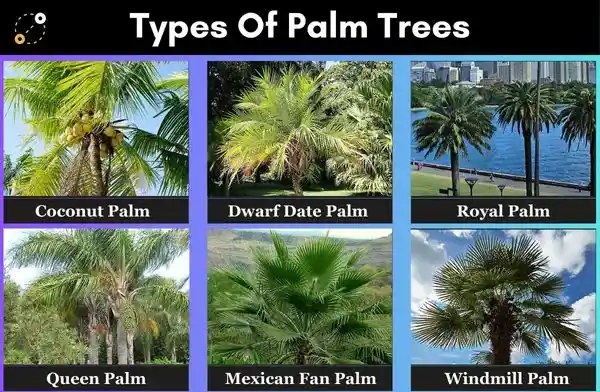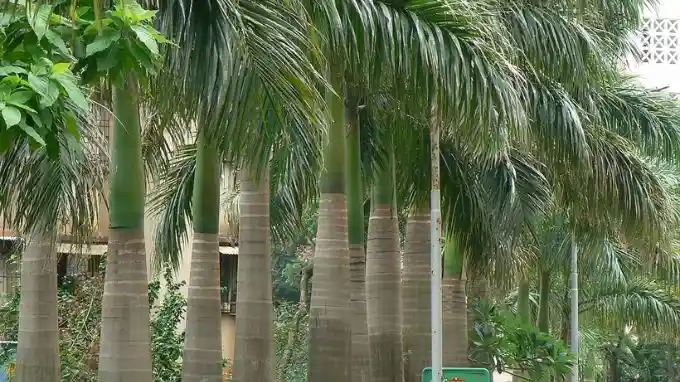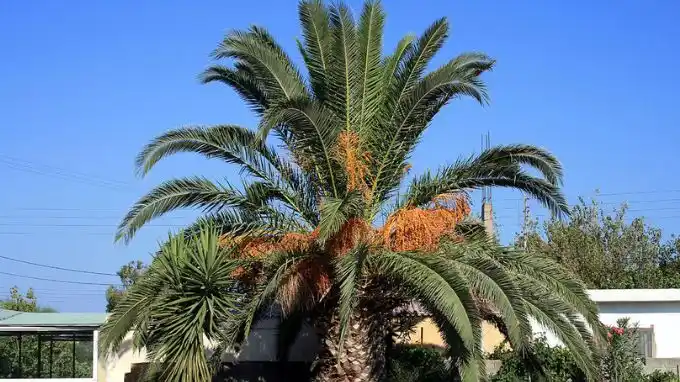With over 2,500 identified species, there are various types of palm trees classified on the basis of characteristics such as size, leaf structure, and the habitat they grow in.

Palm trees are known for their elegant leaves and tropic appeal. From towering giants to little ornamentals that give an exotic touch to gardens, parks, and landscapes, palm trees offer a wide range of options for landscaping.
Let’s explore different types of palm trees highlighting their natural habitat, size, unique characteristics, and many more facts.
Different Types Of Palm Trees
These tropical plants, with their graceful fronds and distinctive shapes, create visions of sun-soaked beaches, tropical paradises, and lush landscapes.
Here is a list of these unique and exotic types of palm trees species –
- Coconut Palm
- Dwarf Date Palm
- Royal Palm
- Queen Palm
- Mexican Fan Palm
- Windmill Palm
- Canary Island Date Palm
- Petite Lady Palm
- Foxtail Palm
- Alexander Palm
- Cabbage Palm
- Bismarck Palm
- African Oil Palm
- Spindle Palm
- Chinese Fan Palm
- Jelly Palm
- Saw Palmetto
- Bottle Palm
- Needle Palm
- Areca Palm
Let’s explore each of them one by one –
Coconut Palm Tree

- Scientific Name – Cocos nucifera
- Origin – Native to tropical regions.
- Height – 30 meters (98 feet) tall.
- Leaves – Large, pinnate leaves of 4 to 6 meters.
- Life Span – 100 years or more.
The Coconut Palm tree is a typical member of the palm family, known for its versatility and cultural significance among the vast range of types of palm trees.
It has a towering height, slender trunk, and feather-like, drooping fronds which come in a variety of colors, from vibrant to light green.
Coconut palm trees produce the well-known coconut fruit famous for their water, flesh and oil. They have high salt tolerance, making them well-suited for coastal environments as well.
This palm species is essential to many people’s livelihoods since it offers food, shelter, and raw materials for a variety of industries.
Dwarf Date Palm

- Scientific Name – Phoenix roebelenii
- Common Names – Dwarf Date Palm or also called Pygmy Date Palm.
- Origin – Southeast Asia such as Laos, Vietnam, and Thailand.
- Size – 6 to 10 feet
- Leaves – Pinnate leaves arranged in a feather-like pattern.
- Life span – 30 to 50 years
The Dwarf date palm is known for its compact size and graceful fronds, distinguishing it among the different types of palm trees.
Its trunk is slender and often covered with old leaf bases, giving it a textured appearance. The fronds are dark green and arch gracefully, adding a touch of elegance to indoor and outdoor spaces.
It is often used as a decorative plant in gardens, courtyards and indoor spaces due to its small size and attractive foliage.
Royal Palm

- Scientific Name – Roystonea spp.
- Origin: Native to tropical regions of the Americas including Caribbean, Central America, and southern Florida.
- Height: 30 to 40 meters (100 to 130 feet)
- Leaves – Large, pinnate leaves with leaflets arranged along a central stalk.
- Life span – 50 to 100 years
The Royal palm has a straight, smooth trunk that tapers towards the top. It has a robust, cylindrical trunk that is typically free of branches, adorned with rings from old leaf scars.
The fronds form an elegant crown at the top of the trunk, swinging gracefully in the breeze.
The Royal palm trunk produces creamy white flowers arranged in clusters, followed by small, round fruits that turn black when ripe.
It is a popular choice for landscaping in tropical and subtropical regions, often lining streets, avenues and parks.
Queen Palm

- Scientific Name – Syagrus romanzoffiana
- Origin – Native to South America, particularly Brazil, Argentina, and Paraguay.
- Height – 50 feet (15 meters)
- Leaves – Pinnate leaves arranged in a feather-like pattern.
- Life span – 20 to 50 years
The Queen Palm is a prominent member among the diverse types of palm trees, known for its graceful manner and tropical allure.
This palm species adds a touch of elegance to landscapes with its slender, gray trunk adorned by a crown of vibrant green, pinnate leaves and arching fronds.
Its ornamental foliage and white flowers in clusters, followed by small, orange-colored fruits creates a lush, tropical ambiance, making it a favored choice for landscaping in subtropical and tropical regions.
With its adaptability to various soil types, the Queen Palm proves to be a versatile and resilient addition to any landscape.
Mexican Fan Palm

- Scientific Name – Washingtonia robusta
- Origin – Native to northern Mexico and Baja California.
- Height – 80 to 100 feet
- Leaves – Large, fan-shaped leaves arranged in a symmetrical crown.
- Life span – 80 to 100 years
Mexican fan palm is one of those types of palm trees that is used in landscaping for its striking appearance.
The foliage of this tropical plant species is typically bright green, adding a tropical touch to landscapes.
It has a smooth, columnar gray trunk that narrows as it rises, often retaining the bases of old leaves.
With its adaptability to various soil types and resilience to urban conditions, it thrives in full sun and well-drained soil.
Windmill Palm

- Scientific Name – Trachycarpus fortunei
- Origin – Native to parts of Asia, like China and Japan.
- Height – 20 to 40 feet (6 to 12 meters)
- Leaves – Large, fan-shaped leaves in a circular pattern.
- Life span – 80 to 100 years
Windmill palms are one of the most cold-hardy types of palm trees species, capable of withstanding freezing temperatures down to 10˚F and snow.
They have a slender, fibrous trunk covered in brown fibers and wrapped in a unique criss cross pattern, adding to its aesthetic appeal.
They have large, fan-shaped fronds, which resemble the blades of a windmill. These leaves are typically dark green in color arranged in a symmetrical crown.
Despite their large size, the fronds of the Windmill Palm trunk are relatively lightweight and flexible making it a popular choice for ornamental plantings in gardens, parks, and urban areas.
Canary Island Date Palm

- Scientific Name – Phoenix canariensis
- Origin – Canary Islands
- Height – 50 to 60 feet (15 to 18 meters) tall.
- Leaves – Feathery, arching leaves
- Life span – 50 to 150 years
The Canary Island Date Palm is a majestic palm species known for its towering height, massive trunk, and lush foliage ranging from bright green to bluish-green in color.
Which makes it a popular choice for landscaping in subtropical and Mediterranean climates worldwide.
One of the most distinctive features of the Canary Island Date Palm is its strong trunk, which can reach remarkable diameters and is covered with visible diamond-shaped leaf scars.
These types of palm trees are well-suited to a variety of landscaping, along streets, parks, and around commercial areas for shade, visual interest, and a tropical ambiance.
Petite Lady Palm

- Scientific Name – Rhapis excelsa
- Origin – Southern China and Taiwan.
- Height – 6 to 8 feet
- Leaves – Fan shaped deeply divided into segments.
- Life span – 20 to 30 years
The Petite Lady Palm among the various types of palm trees, is known for its elegant appearance and suitability for indoor cultivation.
This palm canopy has slender, cane-like stems and dense, dark green, fan-shaped leaves.
The foliage forms a compact, bushy crown, making it an ideal choice for adding a touch of greenery to indoor spaces.
Unlike many other palm species, the Petite Lady Palm is relatively smaller in size and is ideal for bright, indirect light conditions.
It grows in indoor environments with temperatures ranging from 60°F to 80°F (15°C to 27°C).
Foxtail Palm

- Scientific Name – Wodyetia bifurcata
- Origin – Australia
- Height – 30 feet (9 meters) tall.
- Leaves – Look like the bushy tail of a fox.
- Life span – 20 to 30 years
Named for its distinctive fronds that resemble the bushy tail of a fox, the Foxtail Palm is among the unique types of palm trees.
It has a crown of lush, pinnate leaves arranged in a spiral pattern, and a smooth, slender gray trunk, which bulges at the base and tapers towards the top.
It is also ringed with the scars of old fronds, where the trunk serves as a strong base for the palm’s crown of foliage.
Foxtail Palm produces creamy-yellow flowers arranged in clusters, followed by a group of red to orange fruit.
It is widely used as an ornamental palm in landscaping, particularly in tropical and subtropical regions.
Alexander Palm

- Scientific Name – Archontophoenix alexandrae
- Origin – New South Wales in Australia.
- Height – 50 feet (15 meters) tall.
- Leaves: Pinnate leaves with many leaflets arranged along a central stalk.
- Life span – 20 to 50 years
The leaves of Alexander palm are dark green on top and silvery-green underneath, adding to the palm’s aesthetic appeal.
Each leaf can grow up to 10 feet (3 meters) long, creating a lush canopy that provides shade and shelter.
In spring, the Alexander Palm produces clusters of small, creamy-white flowers that give way to bright red or orange fruits.
They grow well in tropical and subtropical climates, and prefer full sun to partial shade and well-drained soil.
As an ornamental palm, the Alexander Palm is often used as a specimen tree or planted in groupings to create a lush tropical effect in gardens, parks, and streetscapes.
Cabbage Palm

- Scientific Name – Sabal palmetto
- Origin – Southeastern United States
- Height – 50 to 70 feet or 15 to 21 meters tall.
- Leaves – Palmate or fan-shaped
- Life span – 100 years
This palm species is renowned for its iconic appearance and resilience, making it a beloved feature of landscapes throughout its native range.
It has a stout, columnar trunk topped with a crown of fan-shaped leaves. The trunk often exhibits a unique “boot-jack” pattern, formed by the persistent bases of old leaves.
The palmate leaves of Cabbage palm are dark green in color. In spring, it produces small creamy-white flowers arranged in clusters, followed by small black fruits that are an important food source for wildlife.
Bismarck Palm

- Scientific Name – Bismarckia nobilis
- Origin – Island of Madagascar in the Indian Ocean.
- Height – 40 to 60 feet (12 to 18 meters).
- Leaves – Segmented
- Life span – 50 to 150 years
The Bismarck Palm stands out as a majestic member among the different types of palm trees.
Distinguished by its symmetrical crown of large, silvery-blue, fan-shaped leaves, the Bismarck Palm creates a dramatic foliage display that captivates onlookers.
It is a prime example of the variety and beauty of types of palm trees, providing landscapes all over the world with an unmatched blend of majesty and beauty.
African Oil Palm

- Scientific Name – Elaeis guineensis
- Origin – West Africa
- Height – 50 to 65 feet (15 to 20 meters) tall.
- Leaves – Pinnate leaves arranged in a spiral fashion.
- Life span – 25 to 30 years
The African Oil Palm is a valuable and one of the unique types of palm trees native to West Africa, prized for its oil-rich fruit clusters.
Its reddish-orange fruit yields kernels rich in oil, extensively harvested for commercial palm oil production globally.
Spindle Palm

- Scientific Name – Hyophorbe verschaffeltii
- Origin – Mascarene Islands
- Height – 15 to 20 feet (4.5 to 6 meters)
- Leaves – Pinnate or feather-shaped
- Life span – 50 to 100 years
The Spindle Palm is a striking palm species known for its unique spindle-shaped trunk and graceful fronds.
It has glossy green, feather-like leaves that can grow up to 6 to 10 feet long.
The Spindle Palm produces small, white flowers and occasional red fruits, it adds tropical elegance to landscapes.
It is one of the cherished ornamental types of palm trees suited for gardens, parks, and resorts, thriving in tropical and subtropical climates with well-drained soil.
Chinese Fan Palm

- Scientific Name – Livistona chinensis
- Origin – Southern Japan, Taiwan, and parts of China.
- Height – 20 to 30 feet
- Leaves – Palmate or fan-shaped
- Life span – 50 to 100 years
The Chinese Fan Palm is a graceful palm having a slender trunk adorned with prominent leaf scars and a crown of large, fan-shaped leaves, bright green and deeply divided.
It grows at a moderately slow pace, and its palmate leaves grow up to 3 to 4 feet wide, creating a tropical ambiance in landscapes.
It grows in subtropical and warm temperate climates, and requires minimal maintenance.
Jelly Palm

- Scientific Name – Butia capitata
- Origin – South America, particularly Brazil, Uruguay, and Argentina.
- Height – 10 to 20 feet
- Leaves – The fronds are pinnate or feather-shaped.
- Life span – 50 to 100 years
The Jelly Palm is a unique addition to the different types of palm trees. It has a stout trunk and arching, blue-green fronds. Its pinnate leaves, reaching 5 to 10 feet, create an elegant canopy.
Known for its clusters of small, yellow flowers and sweet, small, round fruits that are yellow-orange when ripe and have a sweet, jelly-like pulp, hence the name “Jelly Palm.”
It adds both ornamental beauty and edible delight to gardens.
Saw Palmetto

- Scientific Name – Serenoa repens
- Origin – Southeastern United States, particularly Florida.
- Height – 3 to 6 feet
- Leaves – 10 to 20 feet
- Life span – 50 years
The Saw Palmetto is a small palm tree species characterized by its low-growing trunk, typically underground or at ground level, and a crown of fan-shaped, palmate leaves.
These leaves are tough and leathery, bluish-green in color, with serrated edges that resemble a saw, hence the name “Saw Palmetto.”
The Saw Palmetto among different types of palm trees is known for its historical and continued use for medicinal purposes.
They are highly adaptable and can tolerate salt spray, making them ideal for coastal landscapes.
In their natural habitat, Saw Palmettos are commonly found in coastal habitats, including dunes and scrublands.
Bottle Palm

- Scientific Name – Hyophorbe lagenicaulis
- Origin – Mascarene Islands, particularly Mauritius and Réunion.
- Height – 10 to 20 feet
- Leaves – Pinnate or feather-shaped
- Life span – 50 to 100 years
The Bottle Palm stands out among the diverse types of palm trees for its unique appearance and tropical allure.
This palm species is renowned for its distinctive swollen trunk, resembling a bottle or swollen base, which gradually tapers upward.
Topped with a crown of glossy green, feather-shaped leaves, the Bottle Palm adds a touch of exotic elegance to landscapes.
It thrives in tropical and subtropical climates, preferring full sun and well-drained soil.
Needle Palm

- Scientific Name – Rhapidophyllum hystrix
- Origin – Southeastern United States
- Height – 3 to 6 feet
- Leaves – Palmate or fan-shaped
- Life span – 50 to 100 years
The Needle Palm is a resilient and distinctive palm species known for its low-growing stature, having a trunk with sharp, needle-like spines.
Their dark green leaves are deeply divided, providing a unique texture to landscapes. Needle Palms produce flowers that give way to small, round fruits.
Needle Palm is different from the other types of palm trees with its exceptional cold hardiness. It can endure extremely low temperatures as low as -10 to -20 degrees Fahrenheit.
Thriving in various soil types and highly tolerant of salt, Needle Palms are used in landscaping as specimen plants or in mass plantings, particularly in shaded or coastal areas.
Areca Palm

- Scientific Name – Dypsis lutescens
- Origin – Madagascar
- Height – 20 to 30 feet
- Leaves – Pinnate, arranged in a symmetrical pattern along the stems.
- Life span – 20 to 30 years
Originating from Madagascar, Areca Palm is widely cultivated in tropical and subtropical regions worldwide.
Characterized by slender trunks or stems clustered together, topped with gracefully arching fronds, the Areca Palm adds a touch of lushness to landscapes.
Its feather-shaped, pinnate leaves can grow up to 6 to 8 feet long, creating a vibrant canopy.
One unique aspect of the Areca Palm that sets it apart from many other types of palm trees is its ability to act as a natural air purifier.
Conclusion
From the towering Coconut Palm to the resilient Needle Palm, there are many types of palm trees which offer a wide range of options for landscaping, ecological diversity, and cultural significance. Whether adorning tropical beaches, urban streets, or indoor spaces, palm trees add a touch of exotic beauty and charm. Their resilience, adaptability, and ornamental value make them cherished elements of landscapes across the globe.
You May Also Like To Read :
FAQs
What is the most common palm tree?
Most common Palm trees are : Coconut, Dwarf, Royal, Queen, Mexican and Windmill palm tree etc.
Which palm is best for home?
Areca Palm is best for home.
What is the prettiest palm tree?
The prettiest palm tree is Coconut Palm tree.
Which palm grow fast?
Carpentaria Palm is the fastest growing i.e. 3ft / year and reach up to 50ft.




